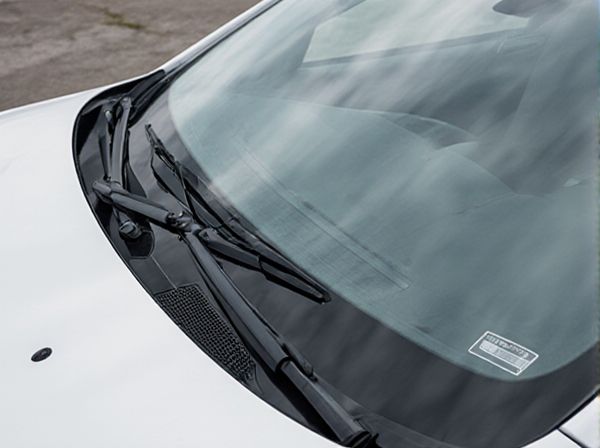
Photo illustration: Heated Wiper vs Standard Wiper
Heated wipers prevent ice and snow buildup, ensuring clear visibility during cold weather and reducing the need for manual scraping. Standard wipers operate effectively in mild conditions but may struggle to clear frost, leading to impaired vision and increased safety risks. Choosing heated wipers enhances your driving safety by maintaining a clear windshield in freezing temperatures.
Table of Comparison
| Feature | Heated Wiper | Standard Wiper |
|---|---|---|
| Function | Melts ice and snow for clear windshield | Removes rain and dirt only |
| Performance in cold weather | High efficiency, prevents wiper freeze | Can freeze, reducing visibility |
| Cost | Higher initial price | Lower cost, budget-friendly |
| Installation complexity | Requires electrical connection | Simple plug-and-play |
| Durability | Resilient against harsh winters | Standard wear and tear |
| Energy Consumption | Consumes vehicle battery power | No energy usage |
| Suitability | Ideal for cold, snowy climates | Suitable for mild climates |
Introduction to Wiper Technologies
Heated wiper systems incorporate embedded heating elements within the wiper blades, enabling them to melt snow and ice for improved visibility during winter conditions, while standard wipers rely solely on physical blade movement to clear rain and debris. Advanced materials and aerodynamic designs enhance the performance of both heated and standard wipers, but heated wipers offer superior functionality in freezing temperatures by preventing ice buildup. Innovations in heating technology and blade composition continue to optimize the efficiency and durability of heated wiper systems compared to traditional wipers.
What Are Heated Wipers?
Heated wipers incorporate embedded heating elements that melt snow and ice on the windshield, providing clear visibility during cold weather conditions. Unlike standard wipers, which rely solely on the wiper blade's physical movement to clear the glass, heated wipers actively prevent ice buildup, reducing the need for manual scraping. This technology enhances safety by maintaining optimal windshield clarity in freezing temperatures.
Understanding Standard Wipers
Standard wipers use rubber blades to clear rain, snow, and debris from windshields, providing basic visibility in typical weather conditions. They rely solely on mechanical movement without any heating element, which can lead to ice buildup and reduced effectiveness during freezing temperatures. Maintenance involves regular blade replacement to prevent streaking and ensure optimal performance in various driving environments.
Performance in Winter Conditions
Heated wipers significantly outperform standard wipers in winter conditions by effectively melting ice and snow on the windshield, ensuring clear visibility and safer driving. Standard wipers often struggle with ice buildup, leading to streaking and impaired vision, which compromises safety during heavy snowfall or freezing rain. The integrated heating element in heated wipers maintains blade flexibility and optimal contact with the glass, providing consistent performance in harsh winter weather.
Durability and Lifespan Comparison
Heated wipers feature integrated heating elements that prevent ice buildup, significantly reducing wear caused by freezing conditions compared to standard wipers. Standard wipers, made from rubber or silicone blades, tend to degrade faster in harsh winter environments due to ice accumulation and frequent scraping. The durability of heated wipers generally results in a longer lifespan, often lasting 20-30% longer than standard wipers under similar cold-weather usage.
Cost and Installation Differences
Heated wipers generally come with a higher upfront cost compared to standard wipers due to integrated heating elements and advanced technology. Installation of heated wipers requires compatible electrical connections and sometimes professional service, increasing labor costs and complexity. Standard wipers offer a more budget-friendly option with straightforward installation, ideal for users prioritizing ease and lower expenses.
Energy Consumption and Vehicle Compatibility
Heated wipers consume slightly more energy than standard wipers due to the electrical heating elements integrated to melt ice and snow, typically drawing around 5 to 10 watts per use, which has minimal impact on overall vehicle energy consumption. Standard wipers rely solely on mechanical motion, making them more energy-efficient but less effective in icy conditions. Heated wipers are compatible with most modern vehicles equipped with 12V electrical systems, while standard wipers fit a broader range of vehicle types without additional electrical requirements.
Maintenance Requirements
Heated wipers require less frequent ice and snow removal maintenance, as their built-in heating elements prevent buildup on the blade and windshield. Standard wipers demand regular manual clearing of ice, snow, and debris to maintain optimal performance and avoid blade damage. Over time, heated wipers tend to experience less rubber degradation, reducing replacement frequency compared to standard wiper blades.
User Experience and Convenience
Heated wipers significantly improve user experience by quickly melting ice and snow, ensuring clear visibility during harsh winter conditions without the need for manual scraping. Standard wipers often struggle to remove frozen debris, leading to reduced efficiency and increased driver frustration. Heated wipers enhance convenience by saving time and effort, allowing safer and more comfortable driving in cold climates.
Which Wiper Is Best for Your Needs?
Heated wipers excel in freezing conditions by melting ice and snow, ensuring clear visibility and safer driving, while standard wipers perform adequately in moderate weather without added cost. Choosing the best wiper depends on your climate; heated wipers are ideal for cold regions with frequent snow and ice, whereas standard wipers suffice in milder, rain-dominant environments. Consider durability, performance in extreme temperatures, and budget to determine the optimal wiper for your vehicle's needs.
 caratoz.com
caratoz.com